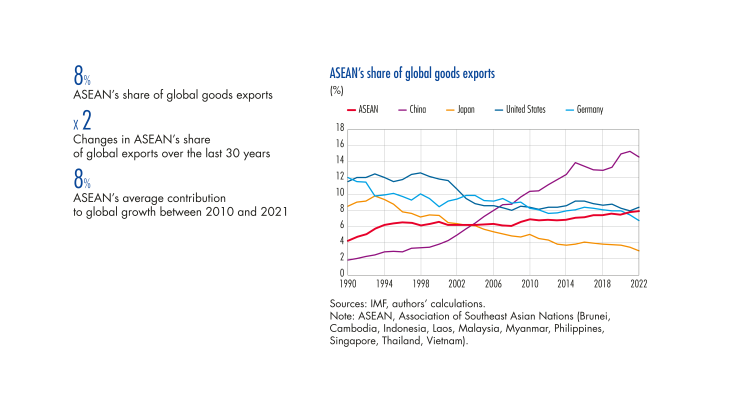1. ASEAN countries increase extra regional trade
South-East Asia’s share of global exports has doubled in the last 30 years
The economic ascent of the ASEAN countries took place in several stages. Initially driven by the industrialization of Asian countries in the 1980s and 1990s (Japan and the Asian dragons: South Korea, Hong Kong, Singapore and Taiwan), their ascent slowed sharply following the Asian crisis of 1997 98. This crisis led to a major restructuring of the economy and the banking sector, particularly in Indonesia, Malaysia and Thailand.
The acceleration in Chinese growth since its admission to the World Trade Organisation (WTO) in December 2001 has had a powerful knock-on effect since the mid-2000s, particularly in South-East Asia, where it has stimulated exports and growth.
The growing market share of ASEAN countries in global exports stems largely from the trade integration process between China and the countries of South-East Asia. Indeed, it is the only region in the world, along with China, to increase its market share in global goods exports.
The region’s trade integration will benefit from the new Asia-Pacific Free Trade Agreement
The regional trade integration process dates back to 1992 and took shape in 2003 with the launch of the ASEAN Free Trade Area (AFTA).
This helped to strengthen regional economic and trade links. Intra-regional trade grew until 2010, accounting for 25% of the foreign trade of ASEAN countries, compared with 20% in the early 1990s. However, since 2010, the trend has reversed and has even accelerated since 2018, reflecting the growing integration of ASEAN into regional trade flows with partner countries in the Asia-Pacific region that make up ASEAN+6, and even beyond the Asia region (see below). This growing openness to the outside world reflects the growth in value chains within the Asian region, particularly in relation to China, as well as ASEAN’s growing role as an exportplatform for the rest of the world.
The production of ASEAN countries is integrated into a vast economic area that extends to East Asia, including mainly China, Japan and South Korea. In 2016, half of ASEAN’s trade in parts and components took place within ASEAN+6 itself (Chen et al., 2019). There are two strands to this: firstly, the sharing of production in ASEAN takes place in an open system, at both the global and regional levels; secondly, ASEAN countries trade relatively more parts and components within the region (ASEAN+6) than with countries outside.
[to read more, please download the article]
